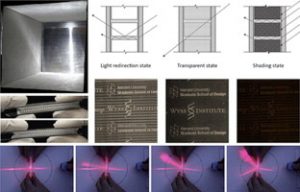 The GSD and the Wyss Institute for Biologically Inspired Engineering have unveiled their first jointly developed patent pending system: the Dynamic Daylight Control System.
The GSD and the Wyss Institute for Biologically Inspired Engineering have unveiled their first jointly developed patent pending system: the Dynamic Daylight Control System.
Currently, office layouts typical in the US rely heavily on shaded windows and artificial lighting to reduce glare and brighten dark areas. The costs are great, economically and ecologically. The new DDCS prototypes developed through the GSD and Wyss collaboration incorporate tiny flexible louvers of transparent rubber between the panes of double glazed windows, to control daylight quality and distribution in the interior space. The system can be dynamically tuned to adjust the interior light in response to different climates and sun positions.
The GSD-Wyss partnership capitalizes on the work of the Materials, Processes, and Systems Group (formerly the Design Robotics Group), led by Martin Bechthold, (professor of architectural technology and director of the GSD’s technology platform), and the Responsive Environments and Artifacts Lab directed by Allen Sayegh (associate professor in practice of architectural technology). They work with Wyss material scientists and chemists to develop nano and micro technologies into applications that solve building-related problems. “We’re always looking at performance and efficiency, but we’re equally interested in questions of design and in what new material systems mean for the overall building,” Bechthold said.
As a result of this interdisciplinary platform, Bechthold says his classes at the iLab–like last year’s “Nano|Micro|Macro: Adaptive Material Laboratory”–have “a slightly different mindset from what we tend to do here” at the GSD. The typical studio focus on exploration and discovery is augmented by an emphasis on product development and cultivating entrepreneurship.
Both Wyss and the GSD are realizing payoffs in advanced results achieved through the collaboration, and bringing us all one step closer to “living buildings” that respond to their conditions with low environmental impact.
Learn more about the Dynamic Daylight Control System and the GSD-Wyss research partnership.